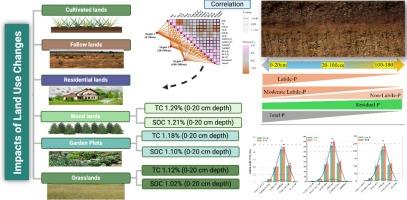土地利用变化对热带地区土壤碳储存和磷组分的影响
IF 5.7
1区 农林科学
Q1 GEOSCIENCES, MULTIDISCIPLINARY
引用次数: 0
摘要
热带地区由人类引起的土地利用变化对土壤养分动态,尤其是碳(C)和磷(P)产生了显著影响。本研究调查了中国海南岛六种不同土地利用类型(休耕地、居民点、林地、园地、耕地和草地)的土壤碳储量和磷组分及其对不同土壤深度土壤磷分布的影响。与休耕地、居民点和耕地相比,林地(1.29 %,1.21 %)、园地(1.18 %,1.1 %)和草地(1.12 %,1.02 %)土壤表层(0-20 cm)的总碳(TC)和土壤有机碳(SOC)含量较高,深土层(20-180 cm)的总碳(TC)和土壤有机碳(SOC)含量明显降低。在较深的土层(20-100 厘米和 100-180 厘米)中,林地和草地土壤的 SOC 和 TC 密度较高(分别为 10.09、15.77 千克/平方米;15.29、17.03 千克/平方米)。利用 Hedley 改良的 Tiessen 和 Moir 方案,P 分馏分析表明了不同土地利用系统中的 P 限制。草地土壤在 0-20 厘米深处的有机钾分馏(NaOH-Po、NaHCO3-Po、HClc-Po)较高,在更深的土层则保持一致。在耕地和草地土壤中,无机钾部分(HClD-Pi)在所有深度的总钾量中占比最大。不同土地利用深度的残余 P 呈稳定趋势。易溶(NaHCO3-Pi、NaHCO3-Po)、中度(NaOH-Po、NaOH-Pi、HClD-Pi)可利用钾组分与各深度碳储量之间的相关性进一步揭示了 SOC 在调节钾可利用性中的关键作用。因此,可以得出结论:土地利用对海南岛的 SOC 和钾储存潜力有不同的影响,且在土层中存在差异。这些发现凸显了因地制宜的土地管理措施对于保持土壤健康以减缓气候变化的重要意义。本文章由计算机程序翻译,如有差异,请以英文原文为准。

Impacts of land use change on soil carbon storage and phosphorus fractions in tropics
Human-induced land use transformations in tropical regions have notably impacted soil nutrient dynamics, particularly of carbon (C) and phosphorus (P). This study investigates soil C stocks and P fractions across six distinct land use types (fallow, residential, woodland, garden plots, cultivated lands, and grasslands) and their influence on soil P distribution at varying soil depths in Hainan Island, China. Higher concentrations of total carbon (TC) and soil organic carbon (SOC) were found in woodland (1.29 %, 1.21 %), garden plot (1.18 %, 1.1 %), and grassland (1.12 %, 1.02 %) soils at the topsoil (0–20 cm), with a noticeable decrease in deep soil layers (20–180 cm) compared to fallow, residential, and cultivated lands. In deeper soil layers (20–100 cm and 100–180 cm), woodland and grassland soils exhibited higher SOC and TC densities (10.09, 15.77 kg m−2; 15.29, 17.03 kg m−2, respectively). Using Hedley’s modified Tiessen and Moir scheme, P fractionation analysis indicated P limitation in different land use systems. Grassland soils had higher organic P fractions (NaOH-Po, NaHCO3-Po, HClc-Po) at 0–20 cm depth, remaining consistent at deeper layers. In cultivated and grassland soils, the inorganic P fraction (HClD-Pi) was the most significant contributor to total P across all depths. There was a steady trend in residual P across the land use depths. Correlations between labile (NaHCO3-Pi, NaHCO3-Po), moderately (NaOH-Po, NaOH-Pi, HClD-Pi) available P fractions and carbon stocks across all depths further revealed the crucial role of SOC in the regulation of P availability. It can thus be concluded that land use differentially influences SOC and P storage potential in Hainan Island, with divergence in soil layers. These findings highlight the significance of region-specific land management practices for maintaining soil health to mitigate climate change.
求助全文
通过发布文献求助,成功后即可免费获取论文全文。
去求助
来源期刊

Catena
环境科学-地球科学综合
CiteScore
10.50
自引率
9.70%
发文量
816
审稿时长
54 days
期刊介绍:
Catena publishes papers describing original field and laboratory investigations and reviews on geoecology and landscape evolution with emphasis on interdisciplinary aspects of soil science, hydrology and geomorphology. It aims to disseminate new knowledge and foster better understanding of the physical environment, of evolutionary sequences that have resulted in past and current landscapes, and of the natural processes that are likely to determine the fate of our terrestrial environment.
Papers within any one of the above topics are welcome provided they are of sufficiently wide interest and relevance.
 求助内容:
求助内容: 应助结果提醒方式:
应助结果提醒方式:


